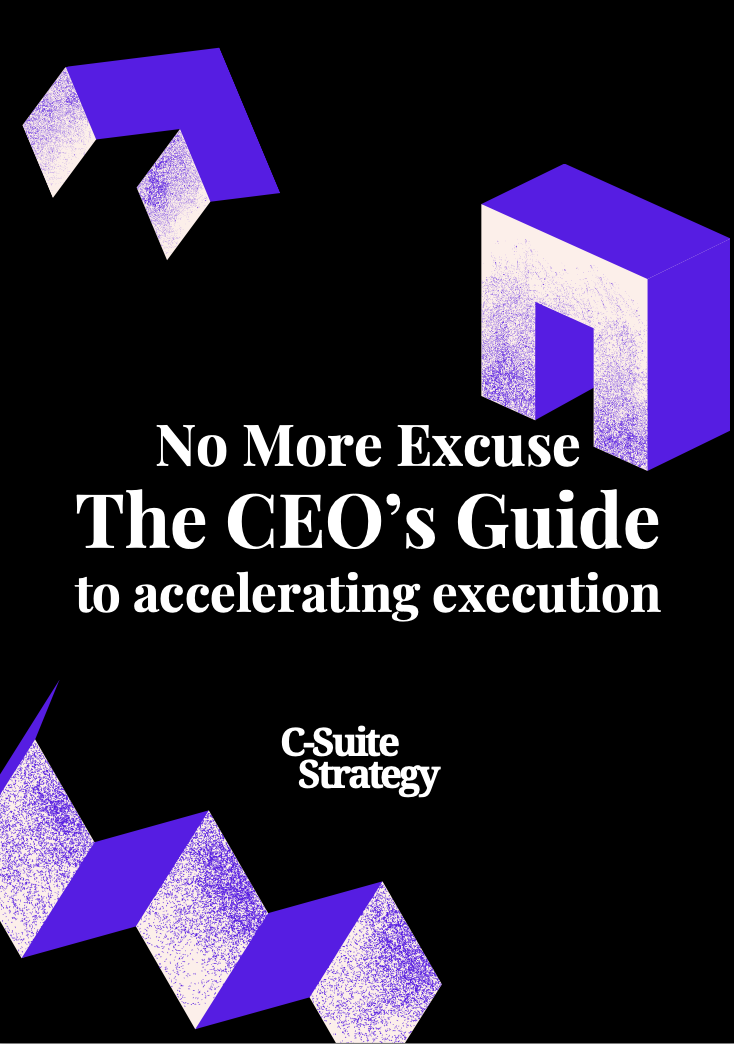Understanding the Core Mission
Clarifying the Company's Purpose for Lasting Impact
As a CEO, one of the most profound questions you'll face revolves around understanding the company's core mission. This isn't merely about crafting a vision statement or slogan; it's about deeply grasping what the business truly stands for and how it differentiates itself within the industry.
It's essential to ask yourself: What does our company fundamentally aim to achieve, and why does it matter in today's world? Understanding this is critical, not just for guiding day-to-day operations but also for setting long-term strategic direction. The core mission should be the north star that guides decision making, ensures company alignment, and empowers employees to understand their role in the bigger picture.
To solidify your company’s mission, consider:
- Employee Engagement: Do your employees align with and genuinely understand the company's mission? Employee experience is greatly enhanced when the staff feels connected to the purpose of the organization.
- Company Culture: Is the mission reflected in the company's culture? An organization's cultural fabric should echo its mission, fostering an environment that nurtures leadership and promotes a cohesive work environment.
- Business Approach: How is the core mission influencing your approach to business challenges and opportunities? A mission-centric company often finds it easier to navigate industry shifts and digital transformation.
By honing in on your company's core mission, you're not only crafting a guiding principle for leadership but also laying a foundation for future decisions. This clarity will help streamline efforts across business units, allowing for a unified approach in tackling the biggest challenges and identifying growth opportunities. As CEOs, understanding the essence of your company is fundamental to shaping a resilient and progressive future.
Evaluating Market Position
The Importance of Market Positioning
In the ever-evolving business landscape, understanding your company's market position is crucial for sustainable success. For any CEO aiming to steer their company towards long-term growth, asking the right questions about its market position should be a top priority. First, consider how your company fits into the broader industry segment. Understanding the company's competitive landscape helps in identifying areas where you can leverage strengths or rectify weaknesses. Reflect on questions such as:- How does the current market position align with our core mission?
- What differentiates our business from competitors?
- Are there emerging trends that could impact our position?
Assessing Organizational Culture
Delving into the Heart of Company Culture
For any CEO, understanding the intricacies of company culture is crucial in aligning the organization’s mission with its core values. This understanding not only shapes the work environment but also reflects in the overall employee experience and engagement. Thus, a thorough evaluation helps promote a culture that resonates with the company’s strategic outlook and long-term vision.
When assessing your organizational culture, consider asking these pivotal questions:
- How does our culture influence decision making at all levels?
- In what ways do our company values align with our strategic business goals?
- What measures are in place to help employees feel supported and valued in their roles?
- What are the biggest challenges in terms of employee engagement that we currently face?
These questions not only reflect the company approach but also guide the CEO’s approach in driving these cultural values across the organization. As the organizational culture becomes more reflective of industry best practices, it influences both the short and long-term strategies positively.
Integrating digital transformation is another layer to consider as it impacts how teams collaborate and engage with one another. A solid digital strategy can enhance communication, streamline processes, and reinforce the company culture.
Ensuring a strong company culture also pertains to leadership—creating an environment where employees are motivated and encouraged to excel at their work. For a deeper dive into strategic leadership approaches, explore insights from strategic leadership resources.
Identifying Growth Opportunities
Exploring Avenues for Business Expansion
In the world of corporate strategy, every CEO grapples with the imperative to identify growth opportunities that align with the company's vision, mission, and market realities. Making informed decisions on where and how to expand can distinguish a thriving organization from one stagnating amidst competition. An effective approach involves blending insights from the company's core mission with a comprehensive evaluation of its market position. This synergy aids CEOs in pinpointing potential opportunities that are not only feasible but also strategic. Here are some essential questions to aid in this endeavor:- What are the emerging trends in our industry? Understanding these can guide the company in leveraging new opportunities and staying ahead of the curve.
- How can digital transformation create value? Consider how embracing technology can enhance the employee experience, streamline operations, and foster a more innovative culture.
- Which segments remain underserved? Identifying gaps where current solutions fall short presents avenues for growth and customer base expansion.
- How does our team perceive potential growth areas? Engaging employees in strategic discussions can yield valuable insights and bolster overall employee engagement.
- Are there adjacent markets worth exploring? Look for related industries where existing capabilities can be redirected to capture new business opportunities.
Risk Management and Mitigation
Prioritizing a Comprehensive Risk Approach
Every CEO understands that risk is an inevitable part of business. However, mitigating risks effectively requires a structured and holistic approach. The risks faced by a company can range from operational mishaps to cybersecurity threats, which have been accentuated with the ongoing digital transformation. By actively understanding the core mission and evaluating market positions, CEOs can identify potential threats early on.
Here are some pivotal questions CEOs should consider when it comes to risk management:
- What are the biggest challenges we face in terms of operational risk, and how do they affect our employees and customers?
- How do we integrate risk management into our company culture, ensuring every team member is engaged in the process?
- In what ways can leadership refine decision making to better foresee long-term threats?
- What external factors or industry-specific risks should be given priority, and how can we prepare for them?
CEOs must also ensure company resilience through proactive employee engagement. By fostering a work environment where employees feel valued and heard, a CEO can enhance risk oversight and prevention. Consider strategies that encourage open communication, allowing employees to voice concerns and offer insights that might help identify risks earlier.
The best approach for any CEO is to regularly review and update their risk management strategies. By aligning them with the company's long-term objectives, you help the business remain agile and competitive. Continuous assessment of risk factors, combined with implementing feedback from employee interviews and experience, strengthens the company’s overall resilience.
Ultimately, a vigilant and adaptive strategy can significantly reduce potential setbacks, ensuring the company remains stable and thriving in an unpredictable market landscape.
Ensuring Financial Health
Financial Stability: A Cornerstone for Growth
In the ever-evolving landscape of business, ensuring financial health is pivotal for both immediate goals and long-term vision. CEOs are tasked with the critical responsibility of maintaining a robust financial foundation to support the company’s overall mission and strategic objectives.
1. Revenue Streams and Diversification: Taking a proactive approach in evaluating and optimizing revenue sources can help in safeguarding against market volatility. CEOs should ask themselves questions regarding current revenue streams: Are they diverse enough to withstand economic downturns? This inquiry will not only aid in risk mitigation but also support stability during uncertain times.
2. Cost Management: Implementing an effective cost-management strategy is essential. CEOs need to delve into understanding costs associated with operations and assess them against achievable benchmarks. By aligning cost strategies with company culture and values, it's possible to foster an environment that champions both efficiency and employee engagement.
3. Cash Flow Management: Questions surrounding cash flow management are critical, as it directly impacts the company’s operational prowess. CEOs should regularly monitor cash flow, ensuring that it aligns with both short-term obligations and long-term investments. This not only supports day-to-day functioning but also enhances the company’s capability to seize potential growth opportunities.
4. Financial Risks and Mitigation Strategies: A thorough understanding of potential financial risks and their mitigation is vital. CEOs must assess potential threats to financial stability and develop comprehensive approaches to address them. Whether assessing market fluctuations or internal inefficiencies, these questions are integral to proactive risk management.
5. Succession Planning: Long-term financial health includes not just immediate concerns but also future leadership transitions. Succession planning is an area often overlooked, yet it’s crucial for continuity. CEOs need to prepare for transitions that align with the company’s values and culture, ensuring that the leadership team is equipped to uphold the financial direction.
Ultimately, the sustainability of a company hinges on financial health. For CEOs, constantly engaging with these questions and aligning decisions with broader business strategy is crucial. Achieving financial well-being is more than monitoring balance sheets—it's about adopting a holistic approach, integrating leadership with company efficiencies, and nurturing a culture where employees can deliver their best work every day.









-large-teaser.webp)


-large-teaser.webp)

